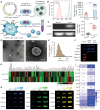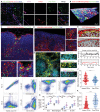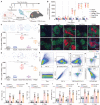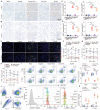Transcript Engineered Extracellular Vesicles Alleviate Alloreactive Dynamics in Renal Transplantation
- PMID: 36073846
- PMCID: PMC9631077
- DOI: 10.1002/advs.202202633
Transcript Engineered Extracellular Vesicles Alleviate Alloreactive Dynamics in Renal Transplantation
Abstract
Direct contact of membrane molecules and cytokine interactions orchestrate immune homeostasis. However, overcoming the threshold of distance and velocity barriers, and achieving adhesion mediated immune interaction remain difficult. Here, inspired by the natural chemotaxis of regulatory T cells, multifunctionalized FOXP3 genetic engineered extracellular vesicles, termed Foe-TEVs, are designed, which display with adhesive molecules, regulatory cytokines, and coinhibitory contact molecules involving CTLA-4 and PD-1, by limited exogenous gene transduction. Foe-TEVs effectively adhere to the tubular, endothelial, and glomerular regions of allogeneic injury in the renal allograft, mitigating cell death in situ and chronic fibrosis transition. Remarkably, transcript engineering reverses the tracking velocity of vesicles to a retained phenotype and enhanced arrest coefficient by a factor of 2.16, directly interacting and attenuating excessive allosensitization kinetics in adaptive lymphoid organs. In murine allogeneic transplantation, immune adhesive Foe-TEVs alleviate pathological responses, restore renal function with well ordered ultrastructure and improved glomerular filtration rate, and prolong the survival period of the recipient from 30.16 to 92.81 days, demonstrating that the delivery of extracellular vesicles, genetically engineered for immune adhesive, is a promising strategy for the treatment of graft rejection.
Keywords: allograft rejection; genetic engineering; immune adhesion; renal transplantation.
© 2022 The Authors. Advanced Science published by Wiley-VCH GmbH.
Conflict of interest statement
The authors declare no conflict of interest.
Figures








Similar articles
-
Injectable Genetic Engineering Hydrogel for Promoting Spatial Tolerance of Transplanted Kidney in Situ.Adv Sci (Weinh). 2024 Dec;11(48):e2408631. doi: 10.1002/advs.202408631. Epub 2024 Nov 5. Adv Sci (Weinh). 2024. PMID: 39498870 Free PMC article.
-
Reduction of Foxp3-expressing regulatory T cell infiltrates during the progression of renal allograft rejection in a mouse model.Transpl Immunol. 2008 May;19(2):93-102. doi: 10.1016/j.trim.2008.03.004. Epub 2008 Apr 28. Transpl Immunol. 2008. PMID: 18503884
-
Single-Cell Heterogeneity Restorative Chimeric Engineering Nanoparticles for Alleviating Antibody-Mediated Allograft Injury.ACS Appl Mater Interfaces. 2023 Jul 26;15(29):34588-34606. doi: 10.1021/acsami.3c06885. Epub 2023 Jul 17. ACS Appl Mater Interfaces. 2023. PMID: 37459593
-
Extracellular Vesicles as Mediators of Cellular Crosstalk Between Immune System and Kidney Graft.Front Immunol. 2020 Feb 27;11:74. doi: 10.3389/fimmu.2020.00074. eCollection 2020. Front Immunol. 2020. PMID: 32180768 Free PMC article. Review.
-
Propagation and characterization of lymphocytes from transplant biopsies.Crit Rev Immunol. 1991;10(6):455-80. Crit Rev Immunol. 1991. PMID: 1830745 Review.
Cited by
-
Targeting Macrophages in Organ Transplantation: A Step Toward Personalized Medicine.Transplantation. 2024 Oct 1;108(10):2045-2056. doi: 10.1097/TP.0000000000004978. Epub 2024 Mar 12. Transplantation. 2024. PMID: 38467591 Review.
-
Unlocking Transplant Tolerance with Biomaterials.Adv Healthc Mater. 2025 Feb;14(5):e2400965. doi: 10.1002/adhm.202400965. Epub 2024 Jul 3. Adv Healthc Mater. 2025. PMID: 38843866 Free PMC article. Review.
-
Nanoparticle-based T cell immunoimaging and immunomodulatory for diagnosing and treating transplant rejection.Heliyon. 2024 Jan 9;10(2):e24203. doi: 10.1016/j.heliyon.2024.e24203. eCollection 2024 Jan 30. Heliyon. 2024. PMID: 38312645 Free PMC article. Review.
-
Frontier role of extracellular vesicles in kidney disease.J Nanobiotechnology. 2024 Sep 20;22(1):583. doi: 10.1186/s12951-024-02852-3. J Nanobiotechnology. 2024. PMID: 39304945 Free PMC article. Review.
-
Injectable Genetic Engineering Hydrogel for Promoting Spatial Tolerance of Transplanted Kidney in Situ.Adv Sci (Weinh). 2024 Dec;11(48):e2408631. doi: 10.1002/advs.202408631. Epub 2024 Nov 5. Adv Sci (Weinh). 2024. PMID: 39498870 Free PMC article.
References
-
- a) Doberer K., Duerr M., Halloran P. F., Eskandary F., Budde K., Regele H., Reeve J., Borski A., Kozakowski N., Reindl‐Schwaighofer R., Waiser J., Lachmann N., Schranz S., Firbas C., Muhlbacher J., Gelbenegger G., Perkmann T., Wahrmann M., Kainz A., Ristl R., Halleck F., Bond G., Chong E., Jilma B., Bohmig G. A., J. Am. Soc. Nephrol. 2021, 32, 708; - PMC - PubMed
- b) Lu X., Ru Y., Chu C., Lv Y., Gao Y., Jia Z., Huang Y., Zhang Y., Zhao S., Theranostics 2020, 10, 8446. - PMC - PubMed
-
- Belardi B., Son S., Felce J. H., Dustin M. L., Fletcher D. A., Nat. Rev. Mol. Cell Biol. 2020, 21, 750. - PubMed
Publication types
MeSH terms
Grants and funding
LinkOut - more resources
Full Text Sources
Other Literature Sources
Medical
